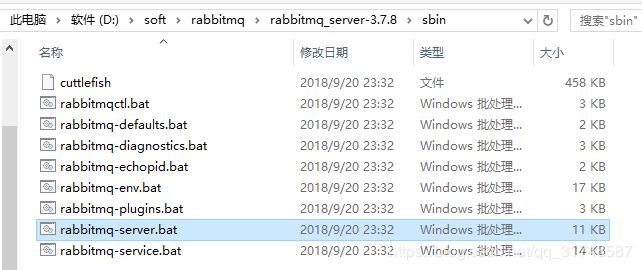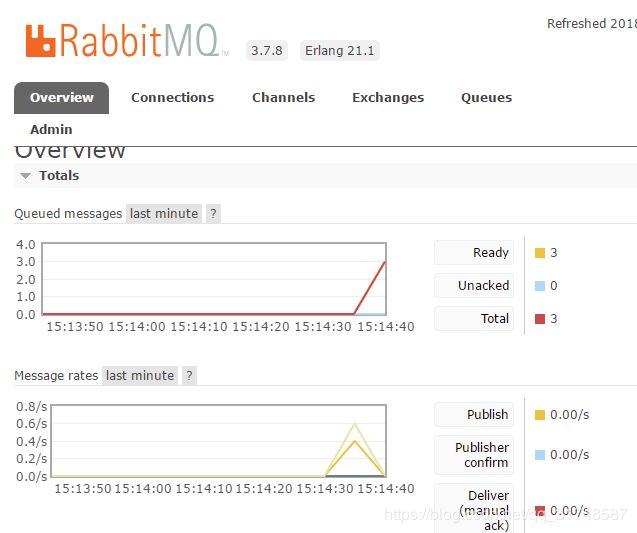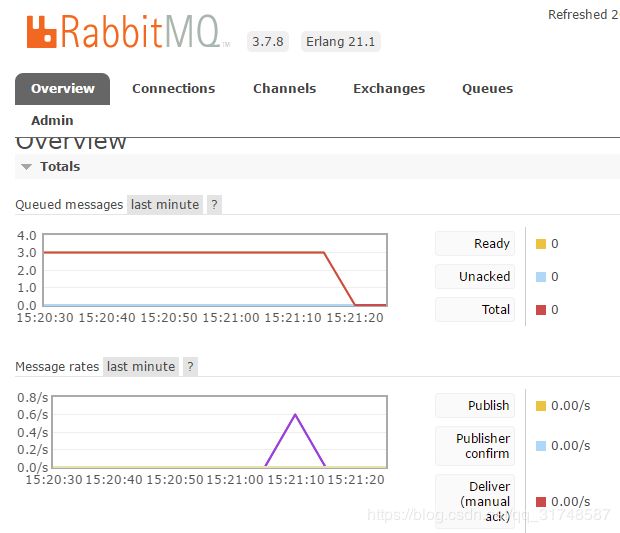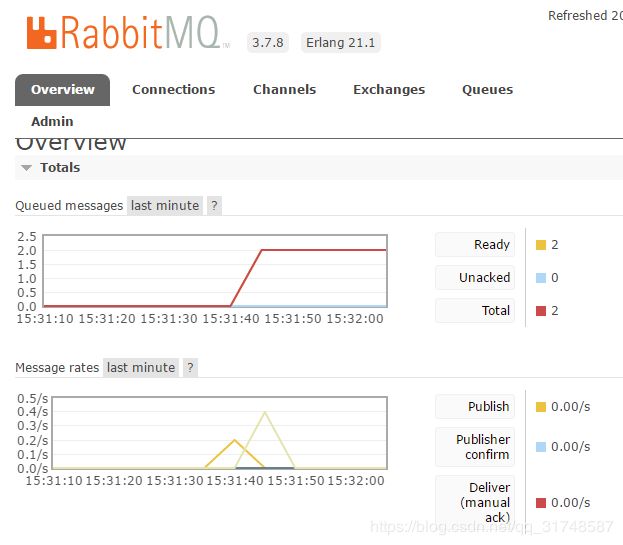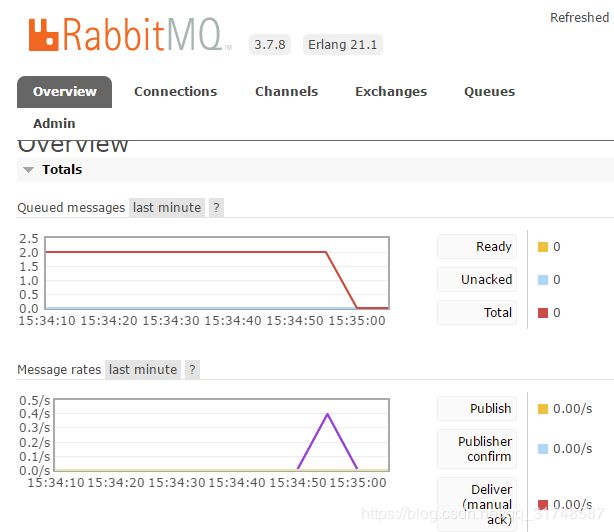springboot整合消息队列——RabbitMQ
正经学徒,佛系记录,不搞事情
RabbitMQ安装,参考博客:https://blog.csdn.net/qq_31748587/article/details/85231015
RabbitMQ常用的三种Exchange Type:fanout、direct、topic。
- fanout:把所有发送到该Exchange的消息投递到所有与它绑定的队列中。
- direct:把消息投递到那些binding key与routing key完全匹配的队列中。
- topic:将消息路由到binding key与routing key模式匹配的队列中。
这里基于springboot整合消息队列,测试这三种Exchange。
- 启动RabbitMQ
双击运行rabbitmq-server.bat
- SpringBoot整合RabbitMQ——Direct模式(默认模式)
创建springboot web项目——发送者springboot-sender
追加测试和rabbitmq所需的依赖
org.springframework.boot
spring-boot-starter-amqp
org.springframework.boot
spring-boot-test
junit
junit
org.springframework
spring-test
5.0.9.RELEASE
修改配置文件application.yml 或 application.properties:
server:
port: 7001
spring:
application:
name: spirngboot-sender
rabbitmq:
host: 127.0.0.1
port: 5672
username: guest
password: guest发送的信息可以是基本数据类型也可以是对象,这里创建一个用户对象
public class User implements Serializable{
private String username;
private String password;
public String getUsername() {
return username;
}
public void setUsername(String username) {
this.username = username;
}
public String getPassword() {
return password;
}
public void setPassword(String password) {
this.password = password;
}
}创建一个配置类:SenderConfiguration.java
一个名为queue1的队列
@Configuration
public class SenderConfiguration {
@Bean
public Queue directQueue() {
return new Queue("queue1");
}
}创建一个发送信息类:SenderService.java
发送user对象给queue1队列
@Component
public class SenderService {
@Autowired
private AmqpTemplate template;
public void sendUser() {
User user=new User();
user.setUsername("张三");
user.setPassword("123456");
template.convertAndSend("queue1",user);
}
}创建一个测试类:TestRabbitMQ.java
@SpringBootTest(classes=SpringbootSenderApplication.class)
@RunWith(SpringJUnit4ClassRunner.class)
public class TestRabbitMQ {
@Autowired
private SenderService senderService;
@Test
public void testRabbit() {
senderService.sendUser();
}
}运行testRabbit方法:
创建springboot web项目——接收者springboot-receiver
修改配置文件application.yml 或 application.properties:
server:
port: 7002
spring:
application:
name: spirngboot-receiver
rabbitmq:
host: 127.0.0.1
port: 5672
username: guest
password: guest添加接收类:ReceiverService.java
@Component
public class ReceiverService {
@RabbitListener(queues="queue1")
public void receiveUser(User user) {
System.out.println("username:"+user.getUsername()+" password:"+user.getPassword());
}
}运行启动类:SpringbootApplication.java,结果:
信息成功被接收。
- SpringBoot整合RabbitMQ——Topic模式(模糊匹配)
步骤与Direct差不多。
发送者:
修改配置类SenderConfiguration.java:
创建两个队列 topic1,topic2,创建一个topic交换器,绑定交换机和队列以及绑定规则
@Bean(name="topic1")
public Queue topicQueue1() {
return new Queue("topic1");
}
@Bean(name="topic2")
public Queue topicQueue2() {
return new Queue("topic2");
}
@Bean
public TopicExchange exchange() {
//创建一个topic交换器
return new TopicExchange("topicExchange");
}
@Bean
Binding bindingExchangeTopic1(@Qualifier("topic1") Queue queueMessage, TopicExchange exchange) {
//设置topic1绑定规则
return BindingBuilder.bind(queueMessage).to(exchange).with("topic.queue");
}
@Bean
Binding bindingExchangeTopic2(@Qualifier("topic2") Queue queueMessages, TopicExchange exchange) {
//设置topic2绑定规则 *表示一个词,#表示零个或多个词
return BindingBuilder.bind(queueMessages).to(exchange).with("topic.#");
}修改发送类SenderService.java:
User user=new User();
user.setUsername("张三");
user.setPassword("123456");
//发送给topicExchange的交换机
template.convertAndSend("topicExchange","topic.queue",user);
template.convertAndSend("topicExchange","topic.anyting",user);运行testRabbit方法:
明明发送了两条,却有三条信息未被接收,这是因为第一条信息topic.queue,即匹配了topic1队列也匹配了topic2队列,而第二条信息topic.anyting只匹配了topic2队列
接收者:
修改接收类ReceiverService.java:
@RabbitListener(queues="topic1")
public void receiveTopic1(User user) {
System.out.println("队列:topic1 username:"+user.getUsername()+" password:"+user.getPassword());
}
@RabbitListener(queues="topic2")
public void receiveTopic2(User user) {
System.out.println("队列:topic2 username:"+user.getUsername()+" password:"+user.getPassword());
}运行启动类,结果:
信息成功被发送和接收
- SpringBoot整合RabbitMQ——Fanout模式(广播模式)
步骤与Direct差不多。
发送者:
修改配置类SenderConfiguration.java:
创建两个队列 fanout1,fanout2,创建一个fanout交换器,绑定交换机和队列以及绑定规则,因为是广播模式,会发送给所有人,所以不需要设置具体的绑定规矩
@Bean(name="fanout1")
public Queue fanoutQueue1() {
return new Queue("fanout1");
}
@Bean(name="fanout2")
public Queue fanoutQueue2() {
return new Queue("fanout2");
}
@Bean
public FanoutExchange fanoutExchange() {
return new FanoutExchange("fanoutExchange");//配置广播路由器
}
@Bean
Binding bindingExchangeA(@Qualifier("fanout1") Queue AMessage,FanoutExchange fanoutExchange) {
return BindingBuilder.bind(AMessage).to(fanoutExchange);
}
@Bean
Binding bindingExchangeB(@Qualifier("fanout2") Queue BMessage, FanoutExchange fanoutExchange) {
return BindingBuilder.bind(BMessage).to(fanoutExchange);
}修改发送类SenderService.java:
User user=new User();
user.setUsername("张三");
user.setPassword("123456");
//发送给fanoutExchange的交换机,不需要配置具体的规则
template.convertAndSend("fanoutExchange","",user);运行testRabbit方法:
成功广播出去两条信息
接收者:
修改接收类ReceiverService.java:
@RabbitListener(queues="fanout1")
public void receiveFanout1(User user) {
System.out.println("队列:fanout1 username:"+user.getUsername()+" password:"+user.getPassword());
}
@RabbitListener(queues="fanout2")
public void receiveFanout2(User user) {
System.out.println("队列:fanout2 username:"+user.getUsername()+" password:"+user.getPassword());
}运行启动类,结果:
消息成功被发送接收
项目地址:
https://pan.baidu.com/s/1UomZkCDlBIL_Bo70X5sASg 提取码: 8g97
